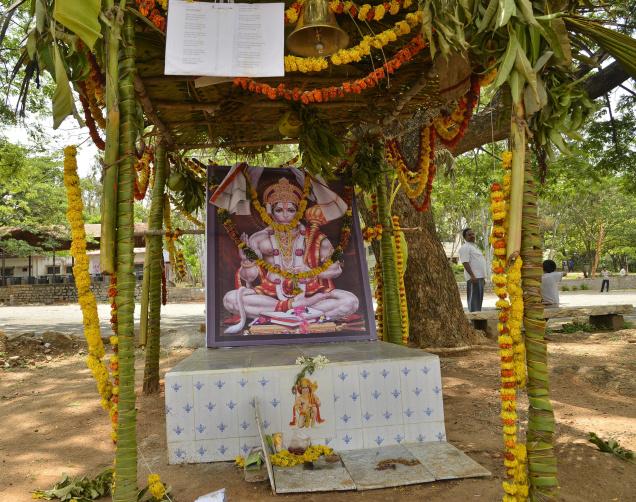
The non-teaching staff buried the monkey and performed puja
A large banner paying homage to a departed soul conspicuously placed near the main administrative building of a university is an unexpected sight. In this case, it is even more bizarre as the obituary is for a monkey which died last month. But what really takes the visitor aback is a miniature “temple”-like structure that they will sight less than a foot away from the banner, in memory of the monkey.
The monkey’s death has resulted in a “temple” coming up within Bangalore University’s Jnanabharathi campus. The “temple”, easily spotted from the administrative building, canteen and bus depot, is replete with a bell, religious texts and a large picture of Lord Hanuman.
Sources said that a feast followed the “establishment” of the “temple”, which is basically a tiled platform built over the monkey’s grave. Members of the university’s non-teaching staff have supposedly established this “shrine”.
Admitting that no permission had been taken to establish the “temple”, Shivanna, deputy registrar and secretary of the SC/ST non-teaching staff association, told The Hindu that the monkey died following a dog bite.
“We organised a feast for around 700 people and built a simple structure over the grave,” he said and added that permission would be sought now from Vice-Chancellor B. Thimme Gowda.
Though no formal complaint has been lodged, several professors are bemoaning the impact such structures will have over the academic ambience of the university.
Meanwhile, registrar (administration) K.K. Seethamma claimed that she was informed by the non-teaching staff that Prof. Gowda had permitted them to bury the monkey.
“We have not given permission to construct the structure. They took permission to conduct a puja after they buried the monkey. Though monkeys are in plenty on the campus, the staff has never buried a monkey. It is said that when a monkey dies, the other monkeys take away the carcass. When the dead monkey was found, the staff sought permission to bury it,” she said.
She also said that the verdant campus is used for dumping animal carcasses on the sly.
Other officials, on the condition of anonymity, said that any opposition to the establishment of religious structures would lead to controversy and threats to strike work.
“There are three big temples on the campus,” they pointed out.


